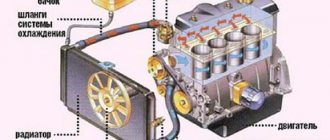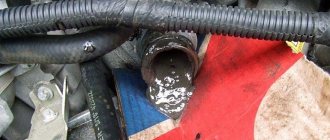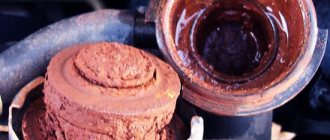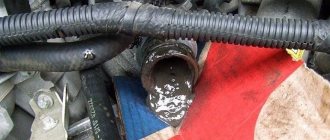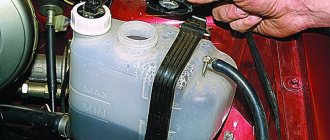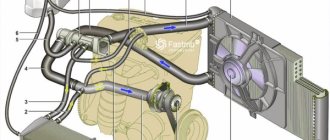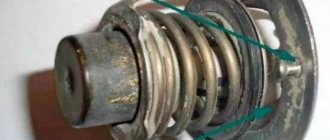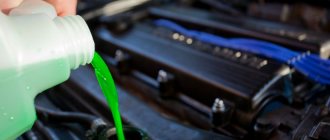There are no small things in the car. The cooling system plays the same important role for normal engine operation as, for example, the ignition system or gas distribution mechanism. Therefore, it requires timely cleaning. This is not as difficult as it might seem at first glance and a lot can be done with your own hands. For example, flush the engine cooling radiator without removing it.
We also recommend reading the article about what a thermostat is. From this article you will learn about the purpose, design and operating principles of a thermostat in a car, as well as common malfunctions of this component of the engine cooling system.
When to wash?
Removal of contaminants from the engine cooling system is carried out as needed; there is no clearly established regulation. If the machine is properly maintained during operation, and the water jacket and heat exchangers are filled with high-quality antifreeze, then sedimentation and deposit accumulation remains minimal. It will take 8–10 years before such a need arises.
A number of signs indicate that a car's cooling elements are clogged:
- the motor constantly operates at a temperature close to the maximum temperature, the electric fan often turns on;
- after pouring fresh antifreeze, the liquid turns dark brown in just a few hours;
- deposits are observed on the inner surface of the filler caps;
- The heat exchanger of the cabin heater warms up the air poorly;
- Antifreeze boils away quickly and has to be topped up frequently.
Note. Symptoms correctly reflect the picture only when the pump and thermostat are in good condition and there are no leaks at the connections.
As a rule, the listed symptoms appear simultaneously, since clogging particles and salts are distributed evenly throughout the system. But first of all, it is the cabin heat exchanger that “overgrows” - its tubes are the thinnest. Simply flushing the radiator is not enough - you need to remove deposits from all channels and components.
How to understand that the stove radiator is clogged
Most often, a stove radiator can be clogged with decay products of the components that make up the coolant. If the clearance of the internal tubes of the heating radiator is completely closed, the part will remain cold even when the engine warms up to operating temperature. In a situation where the contamination of the internal elements of the stove does not reach 100%, the efficiency of the heat exchanger may decrease. The presence of partial blockage can be determined by measuring the temperature of the inlet and outlet pipes. If there is a problem, the difference in heating will be significant.
Testing the heating element should only be done with the engine fully warmed up and the heater on.
Why do stove radiators clog?
The cause of a clogged stove radiator is usually the presence of decomposition products in the coolant. During vehicle operation, antifreeze additives precipitate and settle on the internal surfaces of copper or aluminum tubes. The appearance of mechanical impurities can also be caused by the presence of corrosive destruction of the walls of metal elements. A small amount of deposits can only slightly reduce the efficiency of the cabin heater, but if there is a large accumulation of solids, the circulation of the liquid may completely stop.
Why do you need to flush the cooling system and radiator?
Many domestic car enthusiasts neglect washing and completely in vain. The procedure is not labor-intensive and can be done in the garage on your own. Owners of VAZ cars have been doing this on their own for many years, as well as other types of repair work. All recommendations are quite fair and feasible for owners of imported vehicles.
The radiator and pipelines become clogged during operation. Decomposition products of coolants, all kinds of oil and fat deposits, rust particles and other various scales are deposited in them. As a result, the performance of the radiator and the entire cooling system is reduced. It’s better to wash it in time, and then I’ll tell you how to do it.
Radiator malfunctions can cause expensive repairs or even replacement of components. There are many ways to help get rid of rust and other types of plaque and dirt. It is recommended to perform the flushing procedure while simultaneously replacing the antifreeze at least once every couple of seasons. The final frequency depends on the operating conditions of the particular vehicle.
Cleaning with hydrochloric acid solution
Another dangerous method that is not recommended without similar practical experience.
In addition, hydrochloric acid is quite difficult to obtain. Compliance with safety precautions, as in the case of using sulfuric acid, is simply mandatory. When using acid to get rid of heavy contaminants, you need to fill the cooling system with a 2% acid solution. You will need no more than 50 ml per 1 liter of water. After flushing the heating system, you need to carefully rinse it with water several times. Never use this method if the cooling system consists of parts susceptible to corrosion.
Simplicity: 1
Cost: 3 Time spent: 4 Quality: 5 Result: recommended in case of high levels of contamination.
When is it necessary to flush the engine cooling system?
Contamination of the technical channels of the internal combustion engine is indicated by the constant operation of the fan on the cooling radiator and malfunctions of the heating system. The problem must be resolved as soon as possible. You can do this yourself.
A number of signs indicate the need to flush the engine cooling system:
- regular overheating and problems with subsequent startup of the power unit;
- slow response to the rheostat signal;
- high readings of the coolant temperature sensor after starting the engine;
- pump operation with constant interruptions;
- change in the color of the coolant in the tank.
If such symptoms occur, it is necessary to immediately change the fluid for flushing the engine cooling system.
Additionally, we recommend reading the article by our specialist, which describes in detail the cooling system of the VAZ-2110.
We also recommend that you carefully study our expert’s article on the description of the cooling system of the VAZ-2107.
The system can be cleaned using household products or special chemical additives.
How does an engine cooling radiator work and what is it for?
Everyone has seen a radiator in a car. Roughly speaking, this is a lattice metal screen installed in front of the engine. It consists of many tubes (or rather, one very long twisted tube) and thin, foil-like metal plates. Hot coolant flows through the tube, which transfers heat to these plates and also cools due to the air flow blowing onto the radiator. That is, the coolant, circulating through the engine cooling system, takes heat from it, and then enters the radiator, where it releases heat. The radiator has a neck where coolant (antifreeze, antifreeze or water) is poured.
Flushing the engine cooling system with distilled water
We would like to immediately note that this is the most inexpensive method of flushing the engine cooling system, but it is also the least effective. In terms of time and effort, washing with distilled water is also not in first place. However, in some cases this method will be completely justified.
Naturally, plain tap water cannot be used to flush the engine cooling system. Only distilled water should be used or, at worst, boiled for at least 20 minutes (it contains a minimum of salts).
We recommend: Why a car accelerates poorly: possible causes and their elimination
Flushing the cooling system is carried out simply:
- Fill the radiator with distilled water.
- Start the car and let it idle for about 15-20 minutes.
- Stop the engine and drain the water from the cooling system.
This procedure must be repeated several times until the water becomes clear. This method is only suitable if the car is relatively new and no obvious contamination is visible in the drained antifreeze.
The following two washing methods will be much more effective.
Washing with acetic acid
You will need three bottles of food vinegar (70%).
They are sold in almost every supermarket. Also, don't forget to drain the old antifreeze. Remove the pipes leading to the heater radiator. After this, you need to use a compressor to blow out the remaining antifreeze and rinse the radiator with water. After drying, you need to pour vinegar into it and leave for about an hour. Then thoroughly flush the radiator fluid. To understand what the result of the procedure is, it is better to drain the water into a bucket. The older your “iron horse” is, the more obvious the result. The radiator will need to be blown out and dried again. Now you need to attach the pipes back, fill in antifreeze and start the engine. Simplicity: 5
Cost: 5 Time spent: 4 Quality: 5 Summary: recommended for moderate contamination.
Signs that it's time to clean your cooling system.
If one of the following signs is detected, then it is imperative to clean the engine cooling system:
- The engine temperature rises sharply, and this happens often.
- When the engine is at operating temperature, cold air blows from the heater.
- The pump is not working well.
- The fan turns on early and runs at high speeds.
If such signs and causes appear, you need to study the flushing scheme, how to flush, what to flush with, and how to correctly fill in new coolant.
What you need to know before flushing the heater radiator
Why does the heater radiator clog?
This is what a clog looks like from the inside / drive2.ru A clogged radiator is one of the most common reasons for poor performance of the interior heater.
Most often this happens due to poor-quality coolant, mixing two antifreezes of different compositions, or the use of water. All this leads to the formation of plaque on the walls from the inside. Dirt tightly clogs the already thin radiator tubes with swirlers, disrupting circulation, and there can be no talk of any heating.
How to understand that the problem is a clog
Checking whether the heater radiator is really clogged is quite simple. You need to find two thin pipes going into the cabin through the partition of the engine compartment and feel them. If one of them is hot, and the second is barely warm or cold, then this is a blockage.
In some cases, cold air will blow from the heater, even if both pipes are hot. This may indicate the following: everything inside is so clogged that the heated antifreeze enters the radiator tank and, bypassing the honeycombs, immediately leaves it without having time to give off heat.
What to do about it
The standard solution to this problem is to replace the radiator with a new one. This is what the car service will recommend. Here you will have to fork out money, since the cost of work is added to the price of a new radiator, and this is 2-3 times more expensive than the spare part itself. In modern cars, getting to the radiator is very difficult: you need to remove the trim and dashboard, unscrew the air conditioning pipes, and then refuel it.
The second option is washing directly on the machine. In this case, everything is much simpler and you don’t need to remove anything. It is enough to disconnect the pipes going to the heater, connect a pump with hoses instead and run the flushing solution through the radiator.
How effective is flushing the stove radiator?
Cleaning a radiator is much easier, faster and definitely cheaper than replacing, but this procedure also has its downsides. Flushing is not a panacea; the chances of success are approximately 50 to 50. In advanced cases, there is sometimes no effect.
Again, on older cars the radiator can leak only because the deposits that covered the holes in the tubes are washed away. Well, there is always the possibility of dirt from the cooling system getting into the washed stove again.
And yet, before changing the radiator, many car owners prefer to flush it first.
How to clean oil from the cooling system using citric acid
If an emulsion appears in the cooling radiator (CR), this means that oil is penetrating into the ODS from the engine. This sign indicates a malfunction of the head gasket or the cylinder head itself; operating a car with such a defect is highly not recommended. Before rinsing the emulsion, it is necessary to eliminate the damage, otherwise its formation will continue. Getting rid of oil in the system is not so easy; in some cases you have to rinse it several times and use different products.
Citric acid is a highly effective composition for washing out dirt, including oil residues from the RO; washing is not difficult, but if the insides of the SOD are heavily contaminated, this operation must be repeated several times. Let's look at a specific example of how such a procedure is performed; it is not necessary to copy all the actions exactly, but the principle itself, we hope, will be clear:
- We take bags of citric acid at the rate of 100 g per 1.5-2 liters of antifreeze, prepare the solution in advance by stirring the powder with hot water in some container, dissolve it;
- if the engine is cold, warm it up to operating temperature, then turn off the engine;
- placing a bucket or plastic canister underneath, drain the old coolant from the radiator and cylinder block by unscrewing the corresponding plugs (opening the taps). Where the drain holes are located depends on the car model;
- without installing plugs (without closing the faucets), pour clean water into the expansion tank, flush the system until relatively clean liquid begins to come out of the drain holes;
- close the drain, first fill the SOD with ordinary clean water, warm up the engine, turn it off, pour water through the taps;
- then we pour the citric acid solution prepared in advance into the expansion tank, stir it again, and then start the engine;
- we close the hood, get behind the wheel, drive the car from 15 to 50 km, it is very desirable that the heater tap on the car is open;
- after the trip, drain the solution; most likely, it will be a cloudy, dirty color;
- We repeat the water flush again, closing all the plugs (taps), and fill the system with fresh antifreeze.
If the work is carried out in the summer, you can fill in distilled water for a while to achieve a better effect and drive like this for several days. In the future, you will definitely need to refill the coolant recommended for this type of car, the main thing is not to forget about this change. Even if the emulsion gets into the coolant, you can flush the engine cooling system with diesel fuel, although diesel fuel does not remove slag very effectively, but it fights oil deposits well.
How to flush a stove radiator without removing it
Prepare everything you need
Almost everything you need for cleaning can be found in any garage, or purchased in addition at the nearest auto and household store.
- 150–200 g citric acid;
- bucket for 8–10 l;
- container for draining antifreeze;
- hose about 3 m long;
- clamps;
- wires;
- mesh, gauze or nylon;
- water;
- antifreeze for topping up;
- transfer pump;
- boiler or stove;
- spanners;
- screwdrivers.
Understand the essence of the process
The principle of flushing the stove radiator is as follows. The heater is disconnected from the cooling system and a pump with hoses is connected to it. The chemical is dissolved and heated in a separate container, and then the flushing liquid is circulated through the radiator using a pump. This allows you to dissolve and wash away all accumulated dirt.
To prevent garbage from getting inside again, it is collected and removed at the exit using an improvised filter made of gauze or old nylon tights. Then the radiator is washed with clean water and the standard cooling system hoses are installed in place.
Remove the terminals from the battery
avtosreda.ru
When removing the radiator pipes, you may have to disconnect several wiring connectors. Therefore, in order to avoid errors in the control system, it is better to de-energize the on-board network by removing the terminals from the battery. First negative, then positive.
First make sure that the heater is set to maximum heat. If the control is carried out using a tap, then in the closed position it will block the flow of liquid and interfere with flushing.
Drain the coolant
The heater is filled with antifreeze. To prevent liquid from leaking onto the floor when you remove the pipes, you need to drain it into a previously prepared container through the plug on the main radiator.
Since the stove is not the lowest point of the system, you can drain not all the antifreeze, but only part of it. With due care, this can be done directly through the pipes during removal.
Remove the pipes from the heater radiator
drive2.ru
Find and disconnect the two thin pipes that go into the cabin. They are located between the engine and the engine compartment bulkhead. Usually they are easy to detect, but if you can’t or are afraid to make a mistake, check the car’s documentation or search on the Internet.
Then simply loosen the clamps and remove the tubes by rotating from side to side. Be prepared for some more coolant to leak out of them.
Connect hoses and pump
drive2.ru
Take any hoses of suitable diameter (usually 16 or 18 mm in diameter), put them on the heater pipes and secure with clamps. Connect the free end of one of the hoses to the pump, wrap the other with gauze and lower it into a container for rinsing. Also attach a small piece of hose to the pump to collect liquid.
You should end up with a pattern similar to the one in the photo. As a pump, it is most convenient to use an additional heater pump from the Gazelle, which is sold cheaply in any car store. Other options include a circulation pump from a boiler or a country pump for irrigation.
Prepare and heat the wash
ykt.ru
To remove dirt and scale, specialized products, sewage cleaning reagents, caustic soda and regular citric acid are used. The latter is the safest and no less effective.
Take 5–6 liters of water and add 150–200 g of regular citric acid, stir well and heat the solution. You can heat it using a boiler, on an electric stove or from a gas burner. For maximum effect, the water temperature should be at least 75 °C, and preferably close to boiling.
Start the pump
drive2.ru
Fill the pump intake hose with the solution, quickly dip the tube into the container and turn on the pump by applying power. After this, the flushing process will begin: the liquid will circulate, draining into the bucket and again flowing from it into the radiator.
If the heater is too clogged, water will flow out of it in a weak trickle at first. Then, as the solution is exposed, the pressure will increase.
A complete flush takes from one to several hours, depending on the condition of the radiator. If the contamination is strong, you may have to change the solution to a fresh one.
The main thing is to change the direction of circulation every 15–20 minutes, swapping the hoses on the pump. This will help remove as much dirt as possible.
When relatively clean water flows out of the radiator in a good flow, the flushing can be considered complete.
Flush the radiator with water
mastera23.ru
At the end of the process, you need to wash off the remaining citric acid so that it does not later mix with the coolant in the system.
To do this, it is enough to run several liters of distilled water through the radiator. Drain off the remaining solution, rinse the container, then fill it with water and start the pump as in the previous step.
Fill with antifreeze
fix‑my‑car.ru
After all manipulations with the air stream, remove any remaining water from the radiator and disconnect the flushing hoses. Install the standard ones in their place and secure with clamps.
Check everything again and make sure the plugs are closed. Next, fill in the antifreeze that was drained earlier, and if necessary, add new one so that the level in the expansion tank corresponds to the norm.
Remove air pockets
ton‑center.ru
When removing pipes and flushing, air pockets inevitably form in the cooling system. Over time, they will come out on their own, but because of them, the heater may work intermittently, so it is better to get rid of the air right away.
To do this, you need to drive onto an overpass or a steep hill to raise the car’s radiator as high as possible, and press the gas firmly several times. At this moment, a gurgling sound will be heard inside the heater, which will stop after the plugs come out.
Check the heater operation
avtovzglyad.ru
Warm up the engine well and evaluate the result. If the problem really was a clogged radiator and you did everything correctly, the effect will be pleasantly surprising. The stove will heat like new, and heat will begin to flow from the air ducts within a couple of minutes after starting the engine.
Reasons for clogging
When using a car, small insects and sand get under the hood, so various debris gradually accumulates on the engine. Some accumulates in the radiator and mixes with the liquid. Gradually, the hoses become clogged, the unit ceases to function normally or even fails. Experienced drivers say that flushing the engine radiator should be done every 1 year/2 years.
For normal cleaning on all sides, it is better to remove the engine. However, this takes a long time. Therefore, car owners often think about how to flush the engine cooling radiator without removing it. Both store-bought products and traditional methods can help with this.
How to wash the outside of a car radiator
The cooling radiator is actively used. During operation, it becomes clogged with dirt and debris. Then the heat does not completely escape into the environment, but flows back to the engine. As a result, the motor overheats. The radiator must be cleaned regularly to keep the vehicle in good working order. To clean the outside of the unit, you can use ordinary water. If there is persistent contamination, then water alone will not be enough. Then it is better to take a special substance to clean the outside of the car radiator. There are many universal products on sale that are good at cleaning dirt from the unit. The cost of such substances varies. It depends on the composition and manufacturer.
Auto chemicals contain concentrated components that quickly remove salt deposits, rust, oil stains, and dirt. For external cleaning you will need buckets, brushes, work gloves, rags, and cleaning agent. To wash the outside of the radiator, you must first remove it from under the hood. You can perform the procedure using soapy water and a brush. This is the easiest way to clean the radiator externally. After soaping the knot, it is washed with warm water.
How to flush a cooling radiator
Manufacturers produce effective products for flushing the radiator from the outside. The following substances have good reviews:
- Liqui Moly Kuhler Reiniger. An excellent product for removing scale, dirt with grease particles and chemical compounds.
- Hi-Gear. Designed for old dirt and rust.
- Mannol - External cleaning of the unit removes rust, scale and other deposits.
If external cleaning does not bring results, you will need to perform internal flushing. If there is serious damage, the unit will need to be replaced. In many cases, mechanical cleansing is successfully carried out independently. This solves the problem of overheating. At the same time, they inspect the pipes and hoses, change the radiator cap and thermostat.
Determining the degree of blockage
There are several ways to determine the degree of CO contamination:
- Engine inspection. Its overheating may be due to various reasons, but lack of cooling of the power unit is one of the main ones. If the engine constantly overheats, you need to diagnose the cooling system.
- Checking the expansion tank. The degree of clogging can be determined by the presence of sediment in the tank. But to do this, the container will have to be dismantled. It is unlikely that it will be possible to determine the presence of deposits on a reservoir installed under the hood. You can try shining a flashlight on the container. If a layer of sediment is visible at the bottom, then it’s time to rinse the CO.
- Monitoring the condition of the coolant. The presence of rust and traces of scale in the coolant indicates the need to replace the refrigerant and clean the CO.
- Inspection of hoses. Clogged pipes can be determined by disconnecting one of the hoses. Be careful as refrigerant will begin to escape from the line when disconnected. If you see that blockages inside the pipe are preventing consumables from passing through the system correctly, you should flush it.
We recommend: How to remove a gearbox on a VAZ 2110 in a garage
User VChSLV published a video about cleaning and replacing the refrigerant.
About the causes and consequences of pollution
The engine and cooling system elements of a new car are absolutely clean. Heat exchange in radiators and the engine water jacket is as efficient as possible. Over time, deposits form on the internal surfaces of the channels, impairing the transfer of heat from the coolant. The reasons for the phenomenon are as follows:
- natural oxidation and decomposition of antifreeze;
- pouring untreated water rich in metal oxides (salts) into the system;
- use of low quality antifreeze;
- a crack in the gasket between the main engine block and the cylinder head (cylinder head), through which engine oil penetrates into the cooling channels.
Note. The circulating hot liquid also interacts with gaskets and various sealants, gradually washing away particles of materials. The latter travel through the system and clog the bottlenecks - the radiator honeycombs.
The decomposition process of antifreeze is considered natural and is observed on all cars. The result is sediment in the form of a slippery coating on the inner walls of the pipes and ducts. The phenomenon has virtually no effect on heat transfer until the insulating layer becomes too thick (10–15 years of car operation).
Other reasons arise from improper vehicle maintenance or engine breakdowns. Separately, it is worth mentioning about pouring ordinary water - scale forms when it comes into contact with the cold surface of the heat exchanger tubes. This is a durable heat-insulating coating that often blocks the flow of fluid through the engine cooling radiator.
Clogged cooling system pipes cause the power unit to overheat. Then it’s clear - the wear of the cylinder-piston group accelerates sharply, and the car owner has to repair the engine ahead of schedule.
Determining the degree of blockage
There are several ways to determine the degree of CO contamination:
- Engine inspection. Its overheating may be due to various reasons, but lack of cooling of the power unit is one of the main ones. If the engine constantly overheats, you need to diagnose the cooling system.
- Checking the expansion tank. The degree of clogging can be determined by the presence of sediment in the tank. But to do this, the container will have to be dismantled. It is unlikely that it will be possible to determine the presence of deposits on a reservoir installed under the hood. You can try shining a flashlight on the container. If a layer of sediment is visible at the bottom, then it’s time to rinse the CO.
- Monitoring the condition of the coolant. The presence of rust and traces of scale in the coolant indicates the need to replace the refrigerant and clean the CO.
- Inspection of hoses. Clogged pipes can be determined by disconnecting one of the hoses. Be careful as refrigerant will begin to escape from the line when disconnected. If you see that blockages inside the pipe are preventing consumables from passing through the system correctly, you should flush it.
Causes of clogged engine cooling system
The working coolant has a tendency to “boil over”. Antifreeze, distilled water or antifreeze circulates in the system - these are working coolers, which are monitored by marks in the tank and periodically topped up. Overheating and boiling over leads to loss of coolant properties and the formation of deposits in pipelines and on the internal walls of the radiator.
You can learn how to replace the coolant from our specialist’s detailed material.
We recommend that you additionally read our expert’s article, in which he talks about how to remove air from the engine cooling system.
Possible causes of clogging:
- dust and mechanical inclusions;
- chemical deposits;
- formation of salts (when adding regular water);
- corrosion of the material of the internal elements of CO with precipitation into a clogging sediment.
Changes in color and smell are signals to replace the distillate. If the consistency changes, foreign particles appear, or a contaminated emulsion forms, you must immediately use means to flush the engine cooling system.
Cleaning the air conditioner radiator
In a cabin air conditioning system, a condenser is needed to cool the refrigerant before it enters the evaporator. If you do not want to pump out freon and refill the system, remove the fan, radiator grille, bumper and other elements that interfere with access to the cells. Use a soft brush to wipe off the outer layer of dust, lint and dirt. Spray an aerosol engine cleaner on the inside and outside for 5-10 minutes. Rinse off the muddy dirt with water pressure. Additionally, blow the honeycombs with compressed air and rinse until completely clean.
Intercooler
After removal, be sure to check for oil inside the intercooler and in the air pipes. A small amount of motor oil is normal. But if it pours out of the intercooler, then it is necessary not only to repair the turbine, but also to clean the inside of the intercooler. A mixture of gasoline and diesel fuel works well for this type of washing.
When assembling, pay attention to the fixation of the pipes. On some cars, it is recommended to change the sealing collars during reassembly. Any leak in the compressor circuit will result in loss of power.
Flushing the engine cooling system with acidified water
Our fathers and grandfathers, at one time, washed the engine cooling system with acidified water.
This solution was used when scale or traces of corrosion were found in the drained antifreeze. If they are present in the system, a hose or pipe may suddenly become clogged, which will lead to a malfunction of the entire cooling system and undesirable consequences for the engine.
In this case, simple distillation will no longer help to cope with the problem. To flush the cooling system, you will need to independently prepare a slightly acidic aqueous solution based on one of the following components:
- lemon acid;
- lactic acid;
- vinegar essence;
- caustic soda.
We recommend: Reasons and process for replacing a Ford Focus fuel pump
When flushing using this method, there is one significant drawback - you can add too much acid, which will subsequently simply corrode the rubber and plastic components of the engine cooling system. So you should add acid very carefully.
Flushing is carried out as follows:
- The prepared slightly acidic solution must be poured into the cooling system.
- Start the engine for 15 minutes, then turn it off.
- There is no need to drain the liquid immediately after this. She needs to be allowed to stay inside the system for several hours.
- After 2-3 hours, drain the water from the system and repeat the operation again.
In total, you need to spend about 5-7 hours washing. After the procedure is completed, the remaining solution is removed from the cooling system using a final rinse with distilled water.
However, given the high aggressiveness of the same solution of caustic soda or citric acid, we do not recommend flushing the cooling system with them.
Cleaning with lactic acid.
This method can give good results, but you won't find lactic acid in the supermarket.
Offers for sale are sometimes found on auto forums. Usually 36% acid is sold, but for cleaning you need 6%. Therefore, dilute the acid in a ratio of 1:5 in distilled water. Fill and wait until the formation of carbon dioxide stops. Then you need to drain the dirty liquid.
There are car enthusiasts who prefer to drive their car for several kilometers and only then drain the flushing fluid. However, be careful - despite the fact that this solution is not so aggressive on aluminum parts, the engine can become very hot. And, most importantly, do not forget to neutralize the acid by rinsing the parts with distilled water. The engine should run for about 15 minutes. Only after this can you add antifreeze.
Simplicity: 5
Cost: 4 Time spent: 5 Quality: 4 Result: recommended for moderate to high levels of contamination.
Flushing the engine cooling system.
Antifreezes generally have a service life of 5 years or until the engine travels 250 thousand km. Antifreeze has a service life of 2-3 years. By the way, you can see what happens if you mix antifreeze with antifreeze. Depending on the operation of the vehicle and the quality of the coolant, if the coolant is not changed or if the coolant is diluted, the radiator channels and cooling jacket become clogged. Therefore, to increase the overhaul life of the engine, it is necessary to periodically flush the engine cooling system. You can wash it both in car services and at home in your own garage.
Many drivers clean the cooling system with their own hands. Some use citric acid, some use Coca-Cola, some use diesel fuel, some use special equipment (eg Laurel), some use something else.
Anyone who wants to avoid problems with the engine must flush the cooling system regularly at certain intervals. During engine operation, deposits, rust, oil deposits, sediment and scale accumulate on the walls of the radiator and pipes. There will be much more clogging substances if the engine was running at high speed, the temperature almost reached the red mark.
If the radiator channels and pipes are clogged, then circulation will deteriorate accordingly. And poor engine circulation will create additional problems: the engine will overheat (which may cause the cylinder head to be removed to replace the gasket), cool air will blow from the stove, and engine parts are subject to increased wear.
It is advisable to flush the car's cooling system once a year. To change the coolant you need warm weather.
There is a cooling radiator icon on the instrument panel, which, if lit, indicates either a low level of antifreeze or antifreeze, or that the radiator needs to be cleaned or replaced. This icon is found on some car brands.
Flushing the radiator with complete removal
Dismantling a stove radiator is a labor-intensive process that requires good knowledge of the machine's structure. But in some cases this cannot be avoided. Car enthusiasts who do not have experience in successfully removing a radiator are better off seeking professional help. Ideally, it is better to contact a car service.
Flushing with complete removal is indicated in cases where methods of cleaning the radiator without dismantling have shown to be ineffective.
Removing the heater core will allow you to identify several types of faults at once. For example, in this way you can test the operation of the fan and, if necessary, replace its motor.
Also, during dismantling, it will be possible to thoroughly rinse and clean the heater radiator from the outside. In cars without a filter, a lot of debris and dust accumulates in the air intake. Poplar fluff is extremely dangerous, as it bakes and forms a thick crust. The result is a dirty heat exchanger that is poorly ventilated and generates heat.
It is possible to understand the condition of the pipes, assess the degree of contamination of the radiator cells and the tightness of the seal when closing the air duct dampers only by removing the radiator. The drive of the dampers and the voids in the closed position between them and the stove cause air to enter from the outside, allowing the radiator to pass through. This can happen to both budget cars and expensive foreign cars. And in this case, you definitely shouldn’t experiment with disassembling your car.
Dismantling the heater radiator will allow you to objectively assess the quality of the cooling system. If the radiator does not work, cleaning is absolutely pointless - a complete replacement of the cooling system elements is necessary. Contamination of the cooling system does not occur immediately; dirt accumulates gradually. But the moment when the radiator begins to leak and becomes clogged to the point of complete failure is always an unpleasant surprise. If it is made of a copper alloy, then the issue can be solved with small means - remove the radiator and solder it. If the aluminum radiator is faulty, it is easier to replace it. The cost of repair will most likely be equal to the price of the radiator.
To wash with removal, you do not need to use a pump. You need good pressure of hot water in a special bathroom. During dismantling, they use the entire arsenal of both homemade and professional means for flushing the stove radiator. But there are methods that can only be used by removing the radiator. At home, they pose a health hazard and are too labor-intensive.
Is it worth flushing the cooling system after applying radiator sealant?
When coolant leaks through loose connections in the pipes, car owners quite often use a special sealant that prevents coolant leakage; for this purpose, a special compound is added to the radiator. In many cases, the product really helps get rid of antifreeze smudges, but incorrect dosage of sealant often leads to clogging of the stove radiator. As a result, the stove stops heating normally, which is a rather serious problem. The question arises of how to rinse with minimal loss of time and money in order to restore the functionality of the heater.
The most common advice on this topic that can be heard from car enthusiasts:
- carry out standard washing with citric acid;
- use whey as a washing agent;
- pour Fanta or Coca-Cola into the cooling system for rinsing;
- apply branded auto chemicals High-Gear.
Of course, you can try to use any of the proposed methods here, but, unfortunately, in this situation they do not always work, especially if a lot of sealant has been added. The surest option is to remove both radiators (main and furnace), and then clean and rinse the parts, and blow them with compressed air.
Washing with sulfuric acid
Dismantling in this case is mandatory to avoid damage to the rubber and plastic parts of the cooling system. In today's conditions, this is a rather exotic method, the feasibility of which is highly doubtful. Before starting the procedure, you must follow all safety regulations. It is imperative to protect your eyes with special glasses and the skin of your hands with rubber gloves. It would be a good idea to throw a special robe over your clothes. In addition, use a household respirator that will protect your respiratory tract from toxic fumes. Also use special tongs or grips to prevent direct contact with the solution. In addition, you will need a hydrometer to measure the concentration of the wash liquid. Please note that rinsing requires a 15% acid solution. Therefore, the hydrometer should show a density of 1.1 grams per 1 cubic centimeter. To obtain the solution you also need distilled water and battery electrolyte. It is important to remember that you should never pour water into acid.
On the contrary, you need to carefully add the acid to the water. Old-style radiators made of copper can be washed in a similar way. Parts made of aluminum and zinc, on the contrary, will become unusable.
Simplicity: 1
Cost: 3 Time spent: 4 Quality: 5 Result: recommended in case of high levels of contamination.
Can I wash it with bleach?
It should be borne in mind that one of the components of this solution is sodium hypochlorite, which can corrode aluminum. Moreover, the higher the temperature of the bleach rises, the faster the corrosion process occurs.
When choosing what to flush the cooling system with, you should approach this issue thoughtfully. If you choose the wrong cooling system cleaner, it can quickly cause the radiator to become clogged or fail.
After the cleaning procedure, it is recommended to install an engine cooling system filter to prevent blockages. If you are not sure that you can clean the radiator yourself, it is better to contact a car repair shop.
Washing with whey.
An old folk remedy that was used back in Soviet times.
The serum helps dissolve scale and rust. However, if the stains are too old, the serum will soften them, but will not completely eliminate them. You need to drain the coolant, then pour in two or three liters of whey, strained through cheesecloth. You need to use the machine for a couple of days. After this, it is necessary to drain the serum and rinse the system with water. Some car enthusiasts note that even after thorough flushing, foam forms in the cooling system. Simplicity: 5
Cost: 4 Time spent: 4 Quality: 4 Summary: Recommended for small to medium-sized stains.

